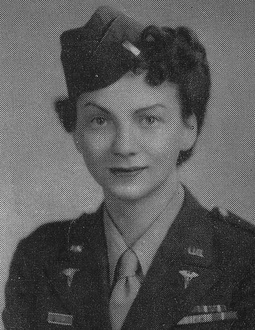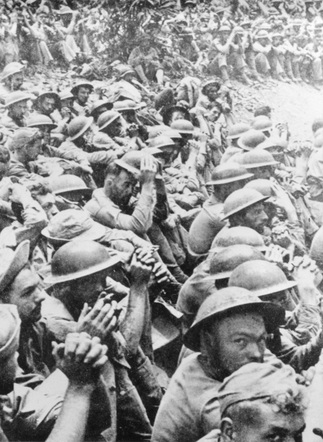 Remembering those at Pearl Harbor, 75-years ago when the surprise attack by the Japanese December 7, launched America into World War II. The American women who resisted the era's prescribed roles for women and served under fire with valor and distinction are sometimes forgotten. If you've read my book Pure Grit you might remember Army Nurse Sally Blaine. This week I'm featuring photos and anecdotes of Sally that couldn't fit in the book. Sally had been serving in the Philippines for several months when another nurse woke her to announce Japan had attacked Hawaii. Sally thought it was a practical joke. But nine hours later, bombs were falling in the Philippines, too. Sally was stationed at Fort Stotsenburg adjacent to Clark Field, home of the largest contingent of the U.S. Air Force in the Far East. “I remember it so vividly. I was tying a shoelace when I heard all those planes going over. I thought they were ours. They bombed terribly and then they came back in little planes and began to strafe the field." Sally ran to the hospital, where a deluge of wounded overwhelmed the staff and filled every available space in the building. The 45-minute air attack destroyed fully half of the U.S. Far East Air Force. Within two weeks the Japanese managed a full-scale land invasion.  Sally said later, that growing up on the land, in a large family making do with very little, prepared her to survive the war. Sally's the smallest girl in the photo at left, with the big smile. But escaping farm life in Bible Grove, Missouri, motivated her to join the army. A young man was courting Sally and wanted to marry her. His proposal was that they go follow the crops for three months. Sally took little time deciding to tell him "no." She went to nursing school, then joined the army. "I had no money, and I knew I would never get to travel unless I went with the military." Still, she never pictured herself setting up hospital beds in the jungle and nursing the wounded amid flying bullets and exploding bombs. But that's what she did as U.S. troops retreated, the Japanese pushing them into the wilds of the Bataan Peninsula. Below, Sally as a teenager in Bible Grove, Missouri. In American war annals, Bataan and Corregidor go down as horrendous defeats. The names are spoken in awe and reverence for the courage and endurance of both the men who survived, and the one-in-three who did not. Until recently, we didn't hear much about the women who were there. A group of nearly one hundred army and navy nurses, including Sally, was the first group of American women ever sent into combat. They were armed only with their nursing skills. "The medicine we practiced was very primitive," Sally said. We had so few things to make the patients comfortable. There was a machine called a Wagenstein Suction to get fluid from the stomach, which we didn’t have. I improvised one and was so proud of myself. Below, an Army doctor and patients in a hospital ward in the Bataan jungle.  "Fortunately, I was a country girl," Sally said. "So, it wasn’t much of a hardship for me. And most of the nurses on Bataan came from similar backgrounds. We were not prima donnas. We’d take off our dirty clothes and pound the dirt out of them with a rocks and a little soap. We’d throw them on some clean rocks, then bathe and put on our clean clothes. 'We didn’t have much privacy. The first time we went to bathe in the open stream, we were very uneasy. The officers stood 30 yards from us with their pistols unsheathed to protect us. But in a few days we realized we were in no danger from the Japanese. Except for the bombs, of course. During bombing raids… I’d get in a tent. It didn’t offer any protection, but I didn’t want patients to see me being afraid. How can you show fear in front of your patients? That causes hysteria. I saw a ward become hysterical." Sally caught malaria, but continued to supervise her ward from a cot. The last day [before the surrender] I admitted 200 patients and put them on the ground. When I say admitted, I mean a sheet of paper with his name on it. They didn’t get blankets because we didn’t’ have any. All the American women on Bataan evacuated to nearby Corregidor Island the night before the army surrendered. (At right, American soldiers surrender, Bataan, P.I., April 9, 1942.) But things were bleak on the island, too, where nurses worked in an underground hospital tunnel. As the Japanese barrage of bombs worsened and another surrender seemed inevitable, the army tried to evacuate the American nurses on a submarine and pontoon planes. There was only room for some thirty of the women, and Sally, one of the sickest, suffering continuing bouts of malaria, was chosen. And here might be the cruelest twist in Sally's story. She was on her way home, rescued mere days before the surrender of Corregidor, and capture of the remaining 54 army nurses. The two small planes carrying 20 nurses landed on Mindanao Island for refueling, last stop before Australia. One plane took off again, but Sally's seaplane was damaged on take-off, stranding the passengers on an island Japanese forces invaded that very morning. Within weeks, Sally and the other nurses were seized and eventually sent to the prison camp in Manila where they joined their comrades from Corregidor. With incredible grit, American nurses survived three years until freed by units of the U.S. First Cavalry Division in early 1945.  Following the war, Sally married Colonel William Millet, commander of a paratroop regiment at Normandy, who was captured prisoner by the Germans. The couple had two sons, Van and Bill, whom Sally raised alone after William died of leukemia. The malaria she contracted on Bataan plagued. Dysentery permanently damaged her intestinal tract, and dengue fever left her with aching joints and limbs the rest of her life. But Sally lived, vital, until 91. Her son Van Millet remembers her with great respect and admiration, saying, "She was one tough lady." Pure Grit has been out nearly three years now, but Sally the the other POW nurses made an indelible impression on me and I think of them often. I continue to reflect on their resiliency and the factors that helped them survive. |
I'm fascinated to discover little-known history, stories of people and events that provide a new perspective on why and how things happened, new voices that haven't been heard, insight into how the past brought us here today, and how it might guide us to a better future.
I also post here about my books and feature other authors and their books on compelling and important historical topics. Occasionally, I share what makes me happy, pictures of my garden, recipes I've made, events I've attended, people I've met. I'm always happy to hear from readers in the blog comments, by email or social media. Archives
September 2023
Categories
All
|


